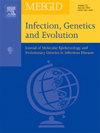Whole-genome sequencing-based characterization of Listeria monocytogenes isolated from cattle and pig slaughterhouses
IF 2.6
4区 医学
Q3 INFECTIOUS DISEASES
引用次数: 0
Abstract
Listeria monocytogenes is a foodborne pathogen that causes human listeriosis and may be transmitted to humans via the food chain, beginning at slaughter and extending through food production and consumption. In this study, we performed whole-genome sequencing (WGS) analysis to determine the genetic characteristics of L. monocytogenes from the carcasses and environments of cattle and pig slaughterhouses in Korea. In total, 50 L. monocytogenes isolates were collected from 46 cattle and 47 pig slaughterhouses nationwide from 2014 to 2022. They were classified into two lineages, 12 sublineages, 12 sequence types, 11 clonal complexes (CCs), and 15 core-genome multilocus sequence types. L. monocytogenes isolates were divided into two lineages: lineage I (serotypes 1/2b and 4b) and lineage II (serotypes 1/2a and 1/2c). The most frequent CCs were CC9 (46.0 %), followed by CC224 (16.0 %) and CC155 (14.0 %). Although all isolates exhibited highly conserved LIPI-1, 20.0 % and 2.0 % contained LIPI-3 or LIPI-4, respectively. Moreover, 96.0 % of the isolates had full-length inlA. Interestingly, 21 of the 23 CC9 isolates contained mutations in inlA resulting from premature stop codon (PMSC). The mdrL and Listeria genomic island-2 (LGI-2) were identified in all L. monocytogenes isolates, whereas LGI-3 was identified in 32.0 % of the isolates. The L. monocytogenes isolates contained various antimicrobial resistance genes, moreover, the plasmid-borne resistance genes tetM and mprF were also identified in 34.0 % and 100 % of the isolates, respectively. Twenty-four isolates (48.0 %) harbored one or two plasmids (pLM33, DOp1, pLGUG1, and pLM5578), and 29 isolates (58.0 %) harbored at least one insertion sequence, composite transposon, and integrative conjugative element. Four isolates showed two CRISPR-Cas types I![]() B and II-A. In addition, phage sequences associated with the spacer constituting the CRISPR array were identified in 26 Listeria phages from 14 L. monocytogenes isolates. The genetic composition of L. monocytogenes was conserved in a collinearity relationship between each of the five L. monocytogenes isolates from the cattle and pig slaughterhouses. These findings suggest that L. monocytogenes isolated from cattle and pig slaughterhouses have the ability to cause human disease and exhibit virulent characteristics.
B and II-A. In addition, phage sequences associated with the spacer constituting the CRISPR array were identified in 26 Listeria phages from 14 L. monocytogenes isolates. The genetic composition of L. monocytogenes was conserved in a collinearity relationship between each of the five L. monocytogenes isolates from the cattle and pig slaughterhouses. These findings suggest that L. monocytogenes isolated from cattle and pig slaughterhouses have the ability to cause human disease and exhibit virulent characteristics.
牛和猪屠宰场单核细胞增生李斯特菌的全基因组测序鉴定。
单核细胞增生李斯特菌是一种引起人类李斯特菌病的食源性病原体,可通过食物链传播给人类,从屠宰开始,并通过食品生产和消费延伸。在这项研究中,我们进行了全基因组测序(WGS)分析,以确定韩国牛和猪屠宰场的尸体和环境中单核细胞增生乳杆菌的遗传特征。总共50个 L。2014 - 2022年从全国46个牛屠宰场和47个生猪屠宰场采集了分离株。它们被划分为2个谱系、12个亚谱系、12个序列类型、11个克隆复合体(cc)和15个核心基因组多位点序列分型。分离的单核增生乳杆菌可分为两个谱系:谱系I(血清型1/2b和4b)和谱系II(血清型1/2a和1/2c)。最常见的cc是CC9(46.0 %),其次是CC224(16.0 %)和CC155(14.0 %)。虽然所有分离株均显示高度保守的LIPI-1,但分别含有20.0 %和2.0 %的LIPI-3或LIPI-4。96.0 %的分离株具有全长inlA。有趣的是,23株CC9中有21株含有由过早终止密码子(PMSC)引起的inlA突变。在所有单核增生李斯特菌分离株中鉴定出mdrL和李斯特菌基因组岛-2 (LGI-2),而在32.0 %的分离株中鉴定出LGI-3。单核增生乳杆菌分离株含有多种耐药基因,其中质粒携带的耐药基因tetM和mprF分别在34.0% %和100% %中检出。24株(48.0 %)含有一个或两个质粒(pLM33、DOp1、pLGUG1和pLM5578), 29株(58.0 %)含有至少一个插入序列、复合转座子和整合共轭元件。4株分离株显示IB和II-A两种CRISPR-Cas类型。此外,在来自14株 L.的26个李斯特菌噬菌体中鉴定出与构成CRISPR阵列的间隔片段相关的噬菌体序列。monocytogenes隔离。从牛和猪屠宰场分离的5株单增李斯特菌的遗传组成均保持共线性关系。这些发现表明,从牛和猪屠宰场分离的单核细胞增生乳杆菌具有引起人类疾病的能力,并表现出毒性特征。
本文章由计算机程序翻译,如有差异,请以英文原文为准。
求助全文
约1分钟内获得全文
求助全文
来源期刊

Infection Genetics and Evolution
医学-传染病学
CiteScore
8.40
自引率
0.00%
发文量
215
审稿时长
82 days
期刊介绍:
(aka Journal of Molecular Epidemiology and Evolutionary Genetics of Infectious Diseases -- MEEGID)
Infectious diseases constitute one of the main challenges to medical science in the coming century. The impressive development of molecular megatechnologies and of bioinformatics have greatly increased our knowledge of the evolution, transmission and pathogenicity of infectious diseases. Research has shown that host susceptibility to many infectious diseases has a genetic basis. Furthermore, much is now known on the molecular epidemiology, evolution and virulence of pathogenic agents, as well as their resistance to drugs, vaccines, and antibiotics. Equally, research on the genetics of disease vectors has greatly improved our understanding of their systematics, has increased our capacity to identify target populations for control or intervention, and has provided detailed information on the mechanisms of insecticide resistance.
However, the genetics and evolutionary biology of hosts, pathogens and vectors have tended to develop as three separate fields of research. This artificial compartmentalisation is of concern due to our growing appreciation of the strong co-evolutionary interactions among hosts, pathogens and vectors.
Infection, Genetics and Evolution and its companion congress [MEEGID](http://www.meegidconference.com/) (for Molecular Epidemiology and Evolutionary Genetics of Infectious Diseases) are the main forum acting for the cross-fertilization between evolutionary science and biomedical research on infectious diseases.
Infection, Genetics and Evolution is the only journal that welcomes articles dealing with the genetics and evolutionary biology of hosts, pathogens and vectors, and coevolution processes among them in relation to infection and disease manifestation. All infectious models enter the scope of the journal, including pathogens of humans, animals and plants, either parasites, fungi, bacteria, viruses or prions. The journal welcomes articles dealing with genetics, population genetics, genomics, postgenomics, gene expression, evolutionary biology, population dynamics, mathematical modeling and bioinformatics. We also provide many author benefits, such as free PDFs, a liberal copyright policy, special discounts on Elsevier publications and much more. Please click here for more information on our author services .
 求助内容:
求助内容: 应助结果提醒方式:
应助结果提醒方式:


